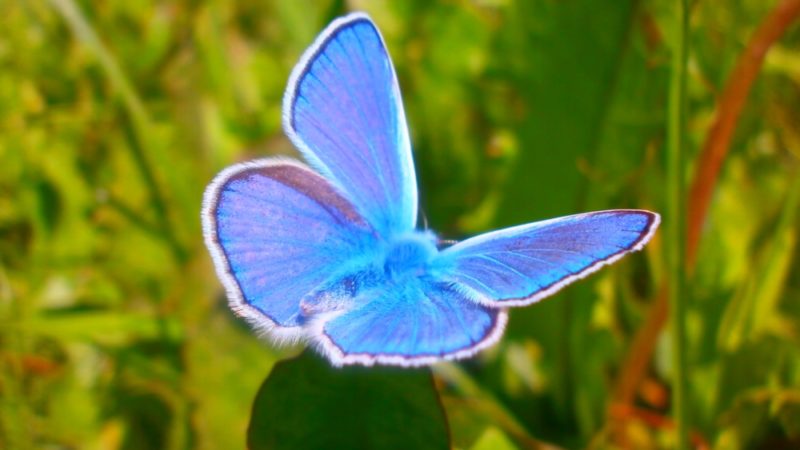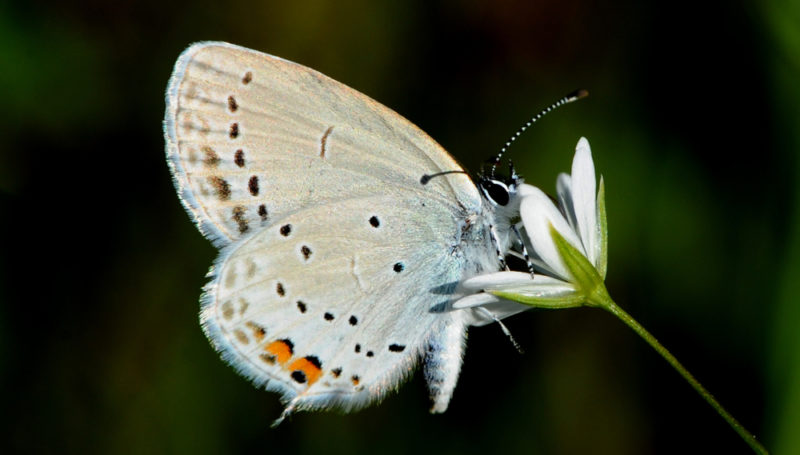Moths with turquoise and sapphire-colored wings flutter vigorously among the herbs from May to August. The entomologist in the description of these lepidopterans will definitely add the specific term “Icarus”, “Arion”, “Osiris” or “Eros” to the name “Lycaena butterfly”. Some species are common for the nature of the European part of Russia, Crimea, Siberia, the Far East, others are threatened with extinction.
Material Content:
Description of Butterfly Lycaena
Many since childhood remember how a polygonum looks because they observed a butterfly in nature. The male of the species Polyommatus icarus is most often found and remembered.
Description of the wings of the butterfly Lycaena-icar:
- Span - from 2.5 to 3.5 cm.
- The length of the front wing is from 1.3 to 1.7 cm.
- A characteristic feature is a pattern in the form of peepholes on the underside.
- The color is blue or bright blue, along the edge there is a white border with black spots.
- In Eastern Europe, there is a subspecies in which the eyes and spots on the fore wing are absent.
Lycaenidae (lat. Lycaenidae) - small day butterflies with blue, violet, copper-orange, yellow, brown coloring. The wingspan varies from 2 to 3.5 cm in species common in temperate climates, and up to 5 cm in the inhabitants of the tropics. These are insects with well-developed three pairs of legs, pronounced sexual dimorphism, a complete transformation cycle. Relatively large eyes, a pair of antennae with olfactory fossae and hairs, proboscis are located on the head.
The scales on the wings of butterflies are modified hairs, the coloring and pattern in the form of stripes, dots depends on them.
In total, the Golubyanka family includes 416 genera, more than 5,000 species distributed throughout the globe (with the exception of the polar regions).Male moths, which belong to the subfamily Polyommatinae, are colored in shades of blue, sapphire, turquoise, gray.
Types of subfamily Tailings have a protrusion on the hind wings in the form of a semicircular lobe. Coloring is the most diverse: brown, gray with a metallic tint, turquoise, emerald. The wings of the butterflies of the subfamily Mnogoglazki variegated with a predominance of yellow, orange or brown.
Character, lifestyle and habitat
Lycaenidae are found in the north of the range from July to August, in the south - from the second half of April to September. Butterflies fly over flowering plants, relax with their wings folded. Insects are especially active in the hot time of the day from 14 to 17 hours.
Many Lycaenidae enter into a relationship with ants called “myrmecophilia”. Caterpillars first feed on a fodder plant, then descend to the ground. Ants find them and take them to their nest. Caterpillars winter in the anthill, affect the behavior of its inhabitants with the help of secreted smelling substances and sweet liquid.
Adults prefer open dry places, flowering meadows. Found in the vicinity of cities and towns, parks, gardens.
Polyommatus-Icarus, as well as other species of this family, inhabit beams, mixed meadows in the forest-steppe zone, along the hillsides, in the subalpine zone of the mountains (up to a height of 2000 m). In the northern part of the range, butterflies can be found in sparse deciduous forests, glades, edges, wet meadows in floodplains.
Insect diet
The presence of fodder plants and ants of certain species has a significant effect on the distribution of Lycaenidae.
Adults suck nectar, the juice of trees, fruits. Caterpillars feed on leaves, buds and flowers of grassy legumes. The diet is dominated by the meadow, sainfoin, alfalfa, meadow clover, peas, vetch, yogurt, astragalus, horned lamb, melilot, strawberries, and gentian. Caterpillars in anthills eat the larvae and pupae of ants.
Reproduction and Life Cycle
Females lay eggs on leaves and flowers of herbaceous plants, which subsequently feed on larvae. Over the summer, Lycaena in the middle lane appears 1 - 2 generations of larvae: the first in late May, the second in early August. In the southern latitudes there can be 2 - 4 generations. Caterpillars emerge from the eggs after 10 days. Larvae are flat and short, similar to wood lice.
Where do butterflies winter
Caterpillars of the last generation overwinter, less often - pupae. Winter is spent in fallen leaves, on the lower part of the stem. Pupation occurs in the topsoil or on the surface.
Interesting Facts
Ants provide "services" to polygonidae. For example, hard-working insects enter into cracks and depressions in the soil of butterfly caterpillars, where they winter safely.
Marshmallow Oak - a large polygamy with a purple color, orange eyes at the base of the "tails" on the wings. Caterpillars harm kidneys and young oak leaves.
Among the interesting facts about lycaenidae, one can mention the abundance of names associated with legends and myths. Brightly colored butterflies appeared to the pundits responsible for taxonomy, the embodiment of divine beauty on earth.
The Orion polyommatus was named after the hunter and simply handsome man Orion, the son of the god of the seas Poseidon, a companion of the ancient Greek patroness of hunting Artemis.
Icarus, in whose honor the species Polyommatus icarus was named, is a hero of the ancient Greek myth who tried to fly on makeshift wings.
The author of the book on butterflies, Yuri Arakcheev, wrote that these "sky-blue, just angelic creatures that do no harm and seem to be created so that we enjoy their beauty!"















